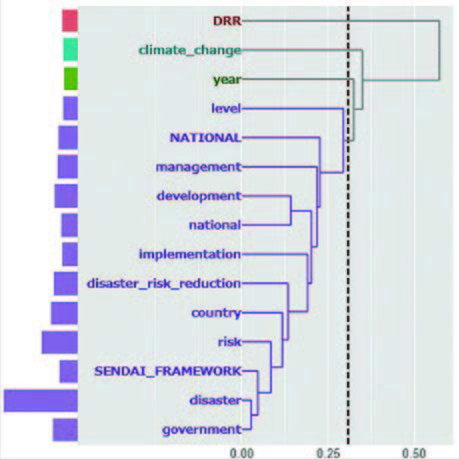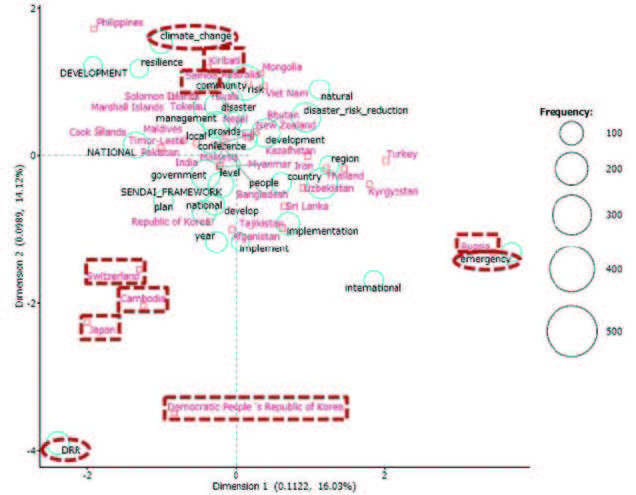2020.5.28
Revealing Attitudes of Countries Towards Disaster Risk Reduction Through Analysis of Offifficial Statements of the 2018 Asian Ministerial Conference on Disaster Risk Reduction

Assist. Professor Daisuke Sasaki
Disaster Information Management and Public Collaboration Division
▷Introduction
It has been 75 years since the birth of the United Nations (UN) and their aim at promoting world peace and cooperation. The UN convenes its annual General Assembly at its headquarters in New York. In addition, it holds separate meetings as needed in order to resolve specific global issues. The UN reconciles the interests of each country at these meetings; if all attending member states agree, the resolution becomes adopted. Afterwards, the resolution serves as a global guideline for countries to align together and move forward into the future. Existing resolutions adopted at such UN conferences include the Sustainable Development Goals (SDGs) on global development and progress, the Paris Agreement on reducing greenhouse gas emissions and adapting to climate change, and the Sendai Framework for Disaster Risk Reduction 2015-2030 (SFDRR) to reduce disaster risks. Since all three resolutions are deeply related to disaster risk reduction (DRR), some experts refer to them as the “three global agendas for DRR—” arguing that they should be closely linked and promoted together.
The SFDRR is the outcome document of the Third UN World Conference on Disaster Risk Reduction (WCDRR), which was held in Sendai in 2015. It encourages the mainstreaming of DRR, investment in DRR during normal times, build-back-better strategies, and setting targets for DRR. From an academic standpoint, IRIDeS has contributed to the formulation and implementation of the SFDRR. The contents of the SFDRR are general outlines for DRR. Therefore, each country needs to implement the contents of the SFDRR in a way that suits its own circumstances during the period when the SFDRR is effective from 2015 to 2030. This
means that the specific interpretation and implementation of the SFDRR is left up to each country, and should result in a diversity of outcomes to some extent. However, there are some questions that arise: how do countries in the world actually see the SFDRR and how are they working on it? Are there any countries that have similar or different stances on DRR from each other?
▷Exploration of countries’ attitudes towards DRR
Assist. Prof. Daisuke Sasaki of IRIDeS conducted a study to answer the above questions.1) Specifically, Sasaki examined the official statements that were expressed by representatives (ministers or acting ministers) of 37 countries2) that attended the 2018 Asian Ministerial Conference on Disaster Risk Reduction (AMCDRR)—which has been three years after the WCDRR.
Why can such statements be regarded as useful research data? It is because a statement made by a country’s representative at an international conference does not contain his or her personal views and, instead, reflects the diplomatic position of the state. They provide valuable information on how each country grasps DRR in the context of diplomacy and international relations. Furthermore, each statement is issued on the same situation, and there is no significant difference in length with each other. Comparison of multiple statements makes it possible to reveal both similarities and differences in standpoints of the countries.
In the study, Sasaki first investigated the overall trend of the 37 countries. After extracting frequently appearing words in all the statements and analyzing the relationships among the words, it was found that words such as “government,” “Sendai Framework,” “disaster risk reduction,” and “development” were used in conjunction with each other (see Figure 1). The results implied that governments were linking DRR policies under the SFDRR with development. In other words, it was suggested that those countries might consider DRR from the perspective of SDGs—as well as the SFDRR.

Second, Sasaki visualized the position of each country towards DRR in two dimensions (see Figure 2). In Figure 2, characteristic words are plotted away from the origin, while the distance between words is not explicitly defined. Additionally, words that are located in the same direction as the country name can be interpreted as being more characteristic of that country. Based on these features, the recognition of DRR of each country was examined by means of identifying similarities and differences that had appeared in Figure 2. For example, the representatives of Kiribati and Samoa focused on climate change, while the representative of Russia grasped DRR in the context of emergency. The statement of Japan was relatively similar to those of Cambodia, Switzerland, and so on.
▷Significance of the study and the future
We feel that we understand the stances of other countries, to some extent, from the media reports. However, Dr. Sasaki’s research is meaningful, as it compared statements of countries on the same criteria and objectively visualized their similarities and differences; providing a clear scientific evidence for global DRR trends.
Regarding this study, Dr. Sasaki points out, “It should be noted that each country’s statement is a political one expressed diplomatically and does not necessarily correspond to how the country is actually working on DRR within and outside of the country,” and “It is not surprising that Pacific island countries such as Kiribati and Samoa focused on climate change in a meeting on DRR, given that these countries are now exposed to disaster risks due to climate change.” On the other hand, Sasaki says, “It seems interesting that Japan did not clearly mention climate change this time. It was out of the scope of this study to examine its background; however, I would like to keep investigating our country’s attitude towards DRR to find out how it changes over time.” Dr. Sasaki also states that the final goal of the research is to clarify how the world has, so far, been treating DRR as one of the most important global issues, and how it should be addressed from now on in the global arena.

[Figure 2]
1) Sasaki, D. (2019). Analysis of the Attitude Within Asia-Pacific Countries Towards Disaster Risk Reduction: Text Mining of the Official Statements of 2018 Asian Ministerial Conference on Disaster Risk Reduction. Journal of Disaster Research, 14 (8), 1024– 1029. doi: 10.20965/jdr.2019.p1024.
2) Afghanistan, Australia, Bangladesh, Bhutan, Cambodia, Cook Islands, Democratic People's Republic of Korea, Fiji, India, Iran, Japan, Kazakhstan, Kiribati, Kyrgyzstan, Malaysia, Maldives, Marshall Islands, Mongolia, Myanmar, Nepal, New Zealand, Pakistan, Philippines, Republic of Korea, Russia, Samoa, Solomon Islands, Sri Lanka, Switzerland, Tajikistan, Thailand, Timor-Leste, Tokelau, Turkey, Tuvalu, Uzbekistan, and Vietnam.
